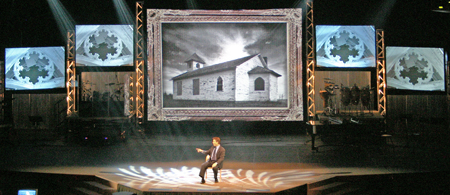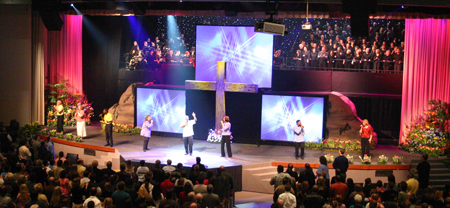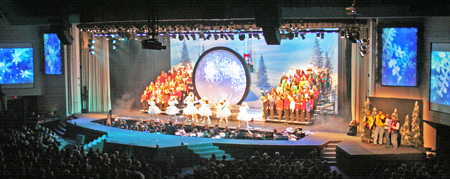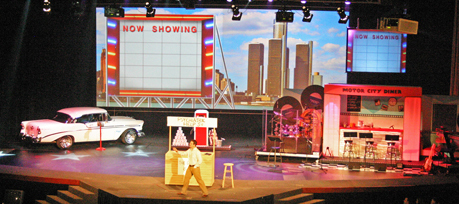My last blog discussed using a large video screen as the backdrop for your church stage. We discussed the benefits of using that type of technology. Today, we’ll move beyond the single screen. There are several reasons why we we would consider using multiple screens to decorate the auditorium of a church. This blog features photos from my time on staff at Northridge Church in Plymouth, Michigan.
The first screen added to most auditoriums is at the rear. This screen is a teleprompter or “confidence” screen typically used for the worship team to read the lyrics. Have you noticed what is displayed on that screen when the congregation is leaving the auditorium? Now that the audience is facing the rear of the auditorium, they will see that screen. Rather than trying to hide the screen, put a graphic on it that ties into the message they just heard. It will become a not so subtle reminder to go and do.
 Back on stage we can place small screens just about anywhere. On the side of the stage, screens can hang like digital artwork. Small screens placed around a large backdrop screen can add supporting images. Large LCD screens can even be hung in the entry way to establish the feel before the audience gets into the room. Circular and other shaped screens will draw visual interest.
Back on stage we can place small screens just about anywhere. On the side of the stage, screens can hang like digital artwork. Small screens placed around a large backdrop screen can add supporting images. Large LCD screens can even be hung in the entry way to establish the feel before the audience gets into the room. Circular and other shaped screens will draw visual interest.

But the most important question remains, “Why use multiple screens in the first place?” In an effort to answer that, let’s look at the benefits of using the technology. During the message, your pastor may like to refer to a specific scripture multiple times. This scripture can be put on the smaller supporting screens and kept for the entire sermon while your main screens project I-mag (image magnification), sermon notes or imagery your pastor is using to support the message. Using “mood” pictures and graphics, you can set the feel of the drama before the actor walks on stage. During worship, you can use additional screens for imagery to support the song that will not be covered over by the main screen(s) song lyrics.

If you have volunteers running the system, you may not think such “complicated” systems are possible for you. The good news is there are volunteer friendly software and hardware solutions, so that operation of such systems is not much more difficult than changing slides in your average PowerPoint. These solutions will make creating the presentation an exciting possibility for volunteers rather than hard work. Remember, engaging your congregation visually is central to communicating the message.

Multiple smaller screens can be combined into one large tiled screen that can operate as either a single image or multiple images. This will give you the flexibility of either type of system.
At Acoustics By Design, we develop audio, video, and theatrical lighting systems for churches of all shapes and sizes. Each ministry has unique needs and goals to be addressed from an audio-visual perspective, but the bottom line is the same – the message must come through with absolute clarity – visually and aurally.

That church has quite the arrangement of church video screens. I can only imagine how upbeat their services must be. My church has one system, Vista Spyder, and an LED video wall and that alone brings so much more liveliness to our services, so again I can only imagine what it’s like to go to a service at this church in Michigan- job well done!